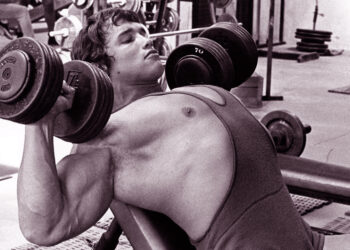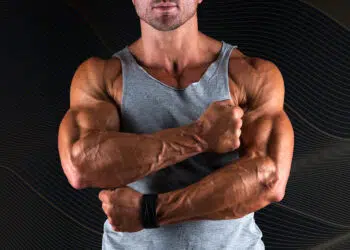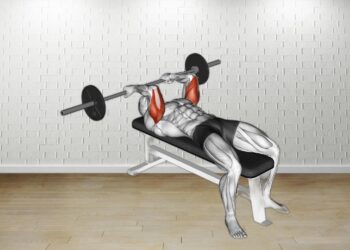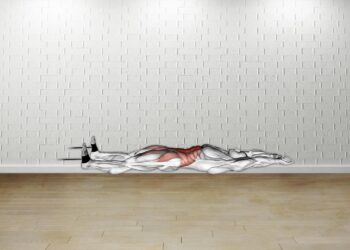Bodybuilders love training their biceps. A jacked dude might tell you that his favorite muscle group to train are his legs, but low-key, it is actually his arms.
Although the arms get more than their fair share of love, only a handful of lifters in every gym have guns worth showing off. One of the main reasons for suboptimal upper-arm gains is a lack of variation in biceps training. Most people usually perform the same exercises (barbell curl, dumbbell curl, hammer curl, and cable curl) in every biceps workout, which leads them to a plateau.
You must vary your training regime to ensure consistent growth. The standing dumbbell preacher curl is one of the most effective yet underutilized biceps exercises. Adding this lift to your exercise arsenal will help you build bigger biceps and improve your upper arm conditioning.
By changing your grip, you can use this isolation (single-joint) movement to target your biceps brachii, brachialis, and brachioradialis. Plus, since you only need a dumbbell and an incline bench for this exercise, most lifters can use it in their training regimens.
In this article, we dive deep into the standing dumbbell preacher curl. We go over how to perform this exercise for the best results, its benefits, common mistakes, and target muscles. To wrap things up, I will leave you with the best standing dumbbell preacher curl variations and alternatives to add variety to your training regimen.
What is a Standing Dumbbell Preacher Curl?
The standing dumbbell preacher curl is an isolation exercise that targets the biceps brachii. The brachialis and brachioradialis muscles receive stimulation as secondary movers. This lift is a seated dumbbell preacher curl variation, but there are some notable differences, like the benches used and weights.
Level Up Your Fitness: Join our 💪 strong community in Fitness Volt Newsletter. Get daily inspiration, expert-backed workouts, nutrition tips, the latest in strength sports, and the support you need to reach your goals. Subscribe for free!
The seated dumbbell preacher curl is usually performed on specialized training equipment, a short bench with an inclined pad, using dumbbells or barbells. However, the standing dumbbell preacher curl is mostly done on an incline bench using a dumbbell.
Since the standing dumbbell preacher curl requires minimal equipment, it is an excellent exercise for people that have access to limited equipment or folks that train in their garage gym.
Changing the angle of your palm while performing the standing dumbbell preacher curl trains your biceps from different angles, ensuring overall development. Furthermore, there are two main standing dumbbell preacher curl variations:
Single-Arm Standing Dumbbell Preacher Curl
This is the most common standing dumbbell preacher curl variation. It involves performing dumbbell curls while resting the back of your upper arm against an incline bench. Since this is a unilateral exercise, meaning you work one side of your body at a time, it is incredibly effective at helping you fix strength and muscle imbalances. Plus, this variation is more accessible to most people.
Double-Arm Standing Dumbbell Preacher Curl
This variation of the dumbbell preacher curl requires specialized training equipment. You need a tall preacher curl bench to place both arms. Only a few training facilities have a standing dumbbell preacher curl bench. That said, this piece of equipment allows you to train both arms simultaneously, giving you the option to perform biceps curls using a barbell. Alternatively, you can use it for the single-arm variation.
How To Do Standing Dumbbell Preacher Curl
Since the single-arm variation of the standing dumbbell preacher curl is more popular, we will stick to it for the sake of this demonstration. This is how to perform the single-arm standing dumbbell preacher curl with a picture-perfect form:
Step 1: Adjust the Incline Bench
Set the incline bench so the back pad is 45 degrees with the floor. The position can vary depending on the exerciser’s height. The edge of the incline bench should be in a position where you can rest your armpit over it by bending over slightly.
Pro Tip: Setting the angle of the bench is one of the most important aspects of the standing dumbbell preacher curl. Adjusting it at an incorrect level will remove tension from your biceps and put it on your shoulder.
Step 2: Set Your Arm on the Bench
Stand behind the inclined bench so that half of your body is behind it. For example, while performing the exercise with your right arm, your right half should be behind the bench, whereas your left side should stay clear of it. Assume a hip-width stance for better stability.
While holding a dumbbell in your hand with a supinated grip, place the back of your right upper arm flat against the incline bench. As you breathe in, slowly lower your forearm until the dumbbell is a few inches off the pad. Place your left hand on the incline bench for stability.
Pro Tip: Keeping your arm at an angle can bias one head of the biceps and strain your wrist, elbow, and shoulders. Avoid moving your upper arm during the exercise to keep constant tension on the target muscle.
Step 3: Curl
Brace your core and bring the dumbbell toward your head by flexing your elbow. Contract your biceps throughout the range of motion and breathe out during the concentric (upward) movement. Your forearm should be almost perpendicular to the floor at the top position. Pause and squeeze your biceps at the static contraction point at the top.
Pro Tip: Ensure that your wrist is in a straight line with your forearm throughout the range of motion. Bending your wrist while lifting heavy can strain the joint.
Step 4: Return To The Start Position
Slowly return to the starting position while taking in a deep breath. However, do not let the dumbbell touch the bench at the bottom of the range of motion. This will ensure constant tension on your biceps. Repeat the exercise for the recommended reps before switching sides.
Pro Tip: For optimal biceps muscle fiber stimulation, keep the rest of your body steady as you perform this exercise.
Standing Dumbbell Preacher Curl Tips:
- While performing this exercise, you must press your chest against the back of the incline bench. This will eliminate the possibility of using momentum by swinging your torso back and forth.
- Maintain a steady rep cadence throughout the exercise to annihilate your biceps. Pausing too long at the static contraction point at the top can lower your training intensity and hamper your hypertrophy ambitions.
- Avoid going too heavy on this exercise as it can hurt your elbow joint and bicep tendon. Furthermore, stop the exercise if you feel a sharp pain or discomfort in your arm during your set.
- Use a neutral grip (palm facing inward) to bias the brachialis. It can help build your overall arm thickness.
- You must limit the movement to your elbow and forearm. If your triceps are gliding on the bench while performing your set, it indicates that you’re relying on momentum.
- Training cues for the standing double-arm preacher curl remain mostly the same. However, you will place both your upper arms against the bench by setting your armpits on the top of the bench’s edge.
Muscles Worked During Standing Dumbbell Preacher Curl
Changing your grip on the dumbbell can help you target your arm from different angles. Here are muscles you can work with the standing dumbbell preacher curl and how to optimize their recruitment:
Biceps Brachii
The conventional standing dumbbell curl that uses a supinated grip primarily targets the biceps brachii. Biceps brachii is a two-headed muscle (short and long) on the front of your upper arm.
Brachialis
Switching from the supinated to a neutral (palm facing inward) grip can bring the focus from the brachii to the brachialis. The brachialis is located under the brachii muscle and can help add thickness to your arm.
Brachioradialis
The brachioradialis runs along the lateral side of the forearm, starting from the lower end of the humerus and attaching to the radius bone in the forearm. You can target the brachioradialis in this exercise by using a pronated (overhand) grip. A false grip can further bias this muscle and help build balanced and proportionate upper and lower arms.
Benefits of Standing Dumbbell Preacher Curl
Here are the benefits of adding the standing dumbbell preacher curl to your exercise regimen:
Improves Biceps Size and Peaks
Performing three to five sets of eight to 12 reps with 60 to 80 percent of your biceps curl one-rep max on this exercise biases hypertrophy, leading to bigger and thicker biceps. Plus, this exercise can improve your biceps peak, adding to your aesthetics. [1]
Builds Strength
This isolation exercise removes the possibility of using momentum since your upper arm rests against an incline bench. You must use your upper arm strength to curl the weight. Lifting 80 to 95 percent of your 1RM on this exercise for one to five reps can boost your strength.
Can Be Used To Train Different Areas of Your Arms
As explained in the “Muscles Worked” section, switching grips (pronated, supinated, and neutral) while performing the standing dumbbell preacher curl can target different muscles in your arms, leading to overall balanced growth.
Perfect For Home Gyms
Since the standing dumbbell preacher curl requires only a dumbbell and an incline bench, you can do it in a bare-bone gym. However, you must master the setup to get the best bang for your buck.
Improves Balance, Coordination, and Mind-Muscle Connection
This unilateral exercise is excellent for zeroing in on your biceps and fixing muscle and strength imbalances. It can also help improve your hand-eye coordination. Plus, it can lead to a better mind-muscle connection and muscle pumps.
Reduces Risk of Injury
Most exercisers lift lighter on the standing dumbbell preacher curl than the conventional biceps curl. Plus, since you cannot overextend your elbow on this exercise since the dumbbell hits the pad at the bottom of the range of motion, it significantly reduces the risk of injury.
Level Up Your Fitness: Join our 💪 strong community in Fitness Volt Newsletter. Get daily inspiration, expert-backed workouts, nutrition tips, the latest in strength sports, and the support you need to reach your goals. Subscribe for free!
Common Mistakes While Performing Standing Dumbbell Preacher Curl
Avoid committing the following errors to get the best bang for your buck on this isolation biceps exercise and limit your risk of injury:
Lifting Your Shoulder Off the Pad
Your armpit should be placed firmly on the bench’s edge throughout the exercise. If your shoulder is off the pad, it allows you to use momentum, which not only reduces the tension on your biceps but also increases your risk of injury.
Moving Your Upper Arm
Most people perform the first few reps of the standing dumbbell preacher curl with a picture-perfect form. However, their form starts to slip during the set’s second half. Moving your upper arm during the exercise can put your wrist, elbow, and shoulder under undue stress and remove tension from your biceps.
Going Too Heavy
Many lifters let their egos get the better of them while performing this exercise. It is also why most people lift their shoulders off the pad or move their upper arm during the exercise. Fix this, and most other things will take care of themselves.
Incorrect Hand Position
You should use a supinated grip on this exercise to target the biceps brachii, a pronated grip to work the brachioradialis, and a neutral grip to train the brachialis. However, what you shouldn’t use is a grip that is in the middle of the three. Having your wrist at an awkward angle increases your odds of hurting your wrist while performing this lift.
Variations of Standing Dumbbell Preacher Curl
The following standing dumbbell preacher curl variations can help improve hypertrophy by working your target muscles from different angles:
Spider Curl
The spider curl might look like a standing dumbbell curl to an untrained eye. However, the setup for this exercise is the mirror opposite of the standing dumbbell preacher curl.
Steps:
- Adjust an incline bench at 45 degrees.
- Grab a dumbbell in each hand.
- Lie supine on the incline bench with your hands hanging on either side of the bench.
- Your upper arms should be perpendicular to the floor.
- Keeping your elbows pinned, curl the dumbbells until they are at shoulder level.
- Pause and contract your biceps at the top.
- Slowly return to the start position and repeat for recommended reps.
Pro Tip: You can do the dumbbell curls on one side at a time to fix muscle and strength imbalances. You can also perform this exercise on a standing preacher curl bench.
Check out our complete spider curl guide here!
Seated Preacher Curl
Most people find the seated preacher curl variations more effective at isolations the biceps, as they remove the lower body from the equation.
Steps:
- Adjust the height of the preacher bench’s seat so that your armpits are just over the edge of the arm pad.
- Grab a dumbbell in each hand.
- Place your triceps on the arm pad while keeping your arms parallel.
- Slowly lower your forearms until they are a few inches off the pad.
- Contract your biceps and flex your elbows to bring the dumbbells to your shoulder level.
- Pause and contract your biceps.
- Rinse and repeat.
Pro Tip: Sit on the edge of the bench to eliminate the possibility of using momentum.
Check out our complete preacher curl guide here!
Dumbbell Reverse Preacher Curl
While the preacher curl works the biceps brachii, the reverse preacher curls biases the brachioradialis. You can perform this exercise on an incline or preacher curl bench. We will stick to the former for this example.
Steps:
- Set the incline bench at 45 degrees.
- Stand behind the bench and place the back of your upper arm against it while holding a dumbbell with a pronated (palm facing down) grip.
- Slowly lower your arm until the dumbbell is a few inches away from hitting the pad.
- Breathe out as you curl the dumbbell to your shoulder level.
- Pause and contract your bicep at the top.
- Repeat for recommended reps before switching sides.
Pro Tip: Use a false (thumbless) grip for better forearm engagement.
Check out our complete dumbbell reverse preacher curl guide here!
Seated Cable Preacher Curl
Using a cable on the preacher curl helps keep constant tension on your biceps, maximizing muscle fiber recruitment and leading to muscle-ripping pumps.
Steps:
- Set the cable pulley at the lowest setting and attach a straight handlebar.
- Set a preacher bench a few feet away from the pulley.
- Grab the handle with a supinated grip and sit on the bench with your upper arms against the bench’s pad.
- Flex your elbows and curl the bar to your shoulder level.
- Pause and contract at the top. ‘
- Slowly return to the starting position.
- Repeat for recommended reps.
Pro Tip: You can also use a rope attachment on this exercise and grab the handles with a neutral grip to focus on the brachialis muscle instead of the brachii.
Check out our complete seated preacher curl guide here!
Alternatives of Standing Dumbbell Preacher Curl
Not a fan of the standing dumbbell preacher curls? Try these exercises instead:
Cable Curl
The cable biceps curl is a staple in most biceps workouts and for good reason.
Steps:
- Set the cable pulley at the lowest setting. Attach a straight handlebar.
- Stand upright with a hip-width stance while facing the pulley.
- Grab the bar with an underhand grip.
- Keeping your elbows pinned to your side, bend your elbows to lift the bar to your shoulder level.
- Pause and contract your guns at the top.
- Slowly return to the start position.
- Rinse and repeat.
Pro Tip: Switch between the overhand, neutral, and underhand grips to target your biceps from different angles and ensure overall development.
Check out our complete cable curl guide here!
Overhead Cable Curl
Ask a bodybuilder to flex his guns, and he will probably hit you with the front double biceps pose. The overhead cable curl mimics this pose and can help perfect your biceps peaks, adding to your aesthetics.
Steps:
- Set the cable pulleys at your eye level and attach D-handle bars on each end.
- Grab a handle in each hand and position yourself in the center of the pulleys.
- Raise your upper arms so they are in a straight line and parallel to the floor. Your lower arms should be 90 degrees to the floor at the start position.
- Keeping your elbows pinned, slowly extend your arms so they are almost in a straight line.
- While breathing out, bring your hands close to your ears by bending your elbows.
- Pause and contract your pythons.
- Repeat for recommended reps.
Pro Tip: You must perform this exercise with a strict form. Avoid going too heavy, as it can force you into using momentum to curl the weights. Furthermore, use a staggered stance if you are facing difficulty maintaining balance.
Check out our complete overhead cable curl guide here!
Zottman Curl
The Zottman curls are one of the few exercises that train your biceps from all angles. Since this exercise involves turning your wrists during the concentrics and eccentrics, it leads to overall biceps and forearm development.
Steps:
- Stand upright with a hip-width stance.
- Hold a dumbbell in each hand against the outside of your thighs with a neutral grip.
- Keeping your elbows pinned to your side, curl the dumbbell to your shoulder level. Rotate the dumbbells clockwise during the concentric motion. Your palms should face the ceiling at the static contraction point at the top.
- At this position, rotate your wrists so your palms face the floor.
- Return to the starting position with a slow and controlled motion.
- Rinse and repeat.
Pro Tip: Besides giving you a nasty biceps pump, this exercise will test your grip strength. Beginners should use 50 percent of their conventional dumbbell curl weight on this exercise.
Check out our complete Zottman curl guide here!
Wrapping Up
If you’ve hit a plateau and traditional biceps exercises aren’t yielding desired results, the standing dumbbell preacher curl is the solution you’re seeking. Since this exercise removes the possibility of using momentum, most people lift moderate weights on this lift, significantly limiting their risk of injury.
This article covers everything you need to know about this exercise to get the best bang for your buck. Plus, I have included seven variations and alternatives to make your workouts more interesting. So, what are you waiting for? Get curling. Best of luck!
References
- Schoenfeld BJ, Grgic J, Van Every DW, Plotkin DL. Loading Recommendations for Muscle Strength, Hypertrophy, and Local Endurance: A Re-Examination of the Repetition Continuum. Sports (Basel). 2021 Feb 22;9(2):32. doi: 10.3390/sports9020032. PMID: 33671664; PMCID: PMC7927075.
Interested in measuring your progress? Check out our strength standards for Barbell Curl, Dumbbell Curl, Preacher Curl, and more.








